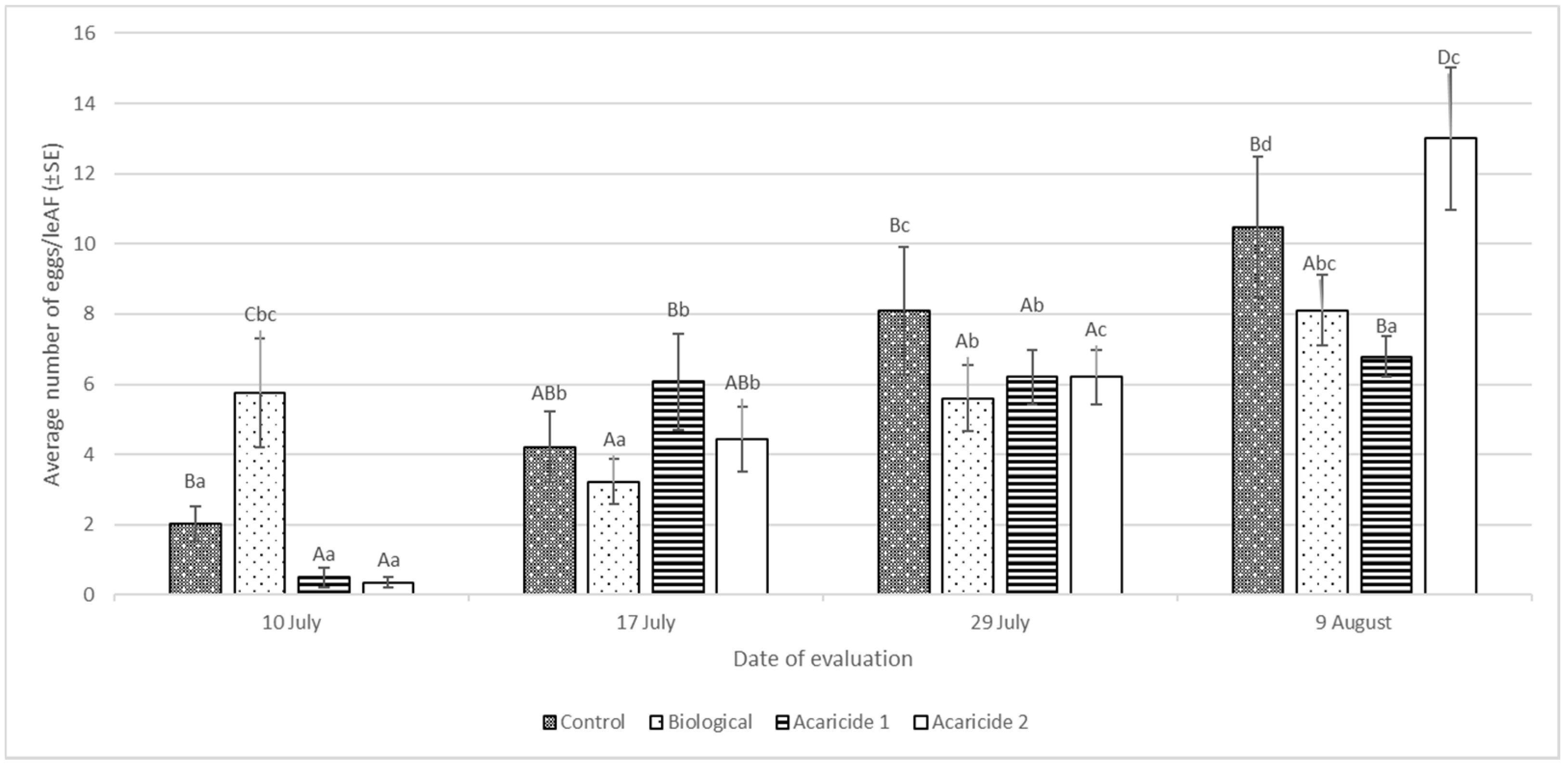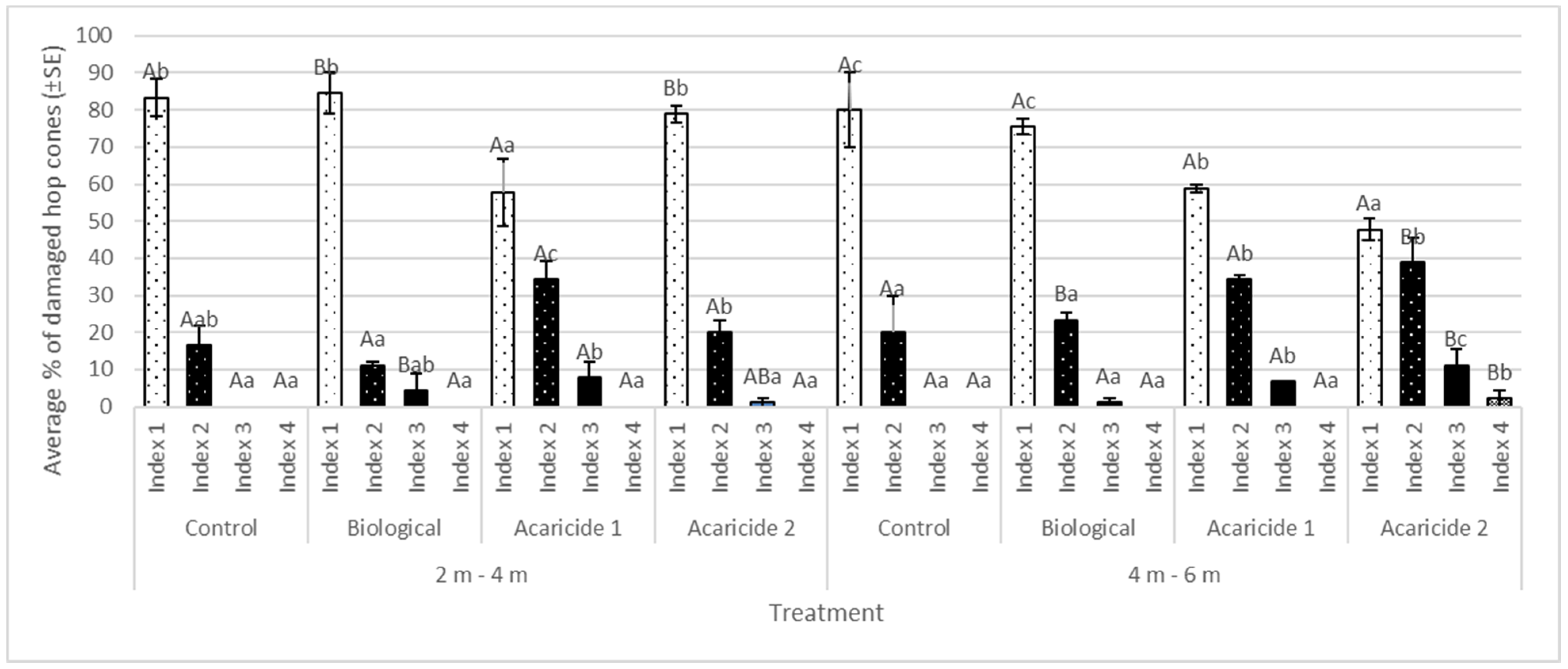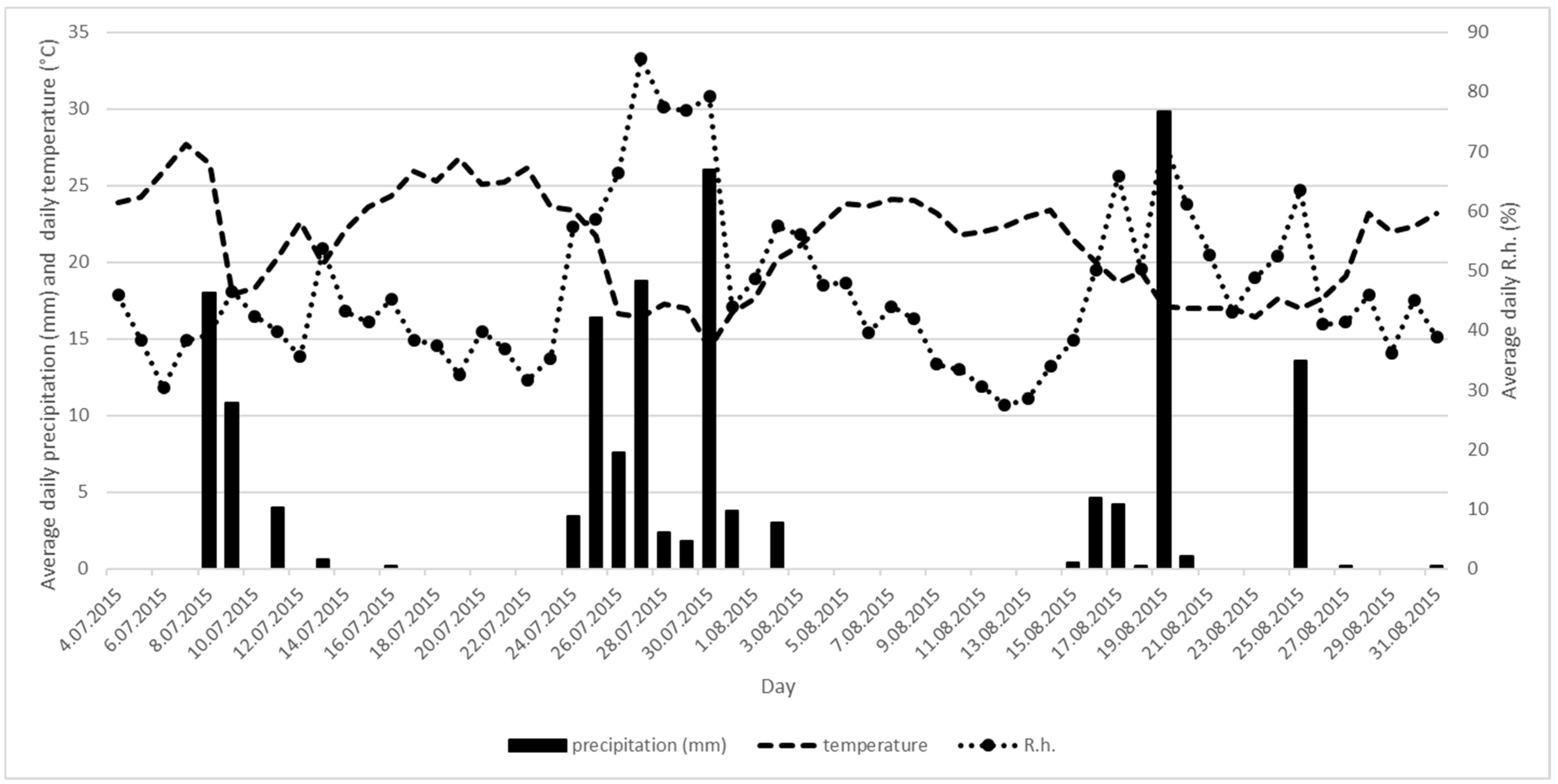Results of the Single Release Efficacy of the Predatory Mite Neoseiulus californicus (McGregor) against the Two-Spotted Spider Mite (Tetranychus urticae Koch) on a Hop Plantation
Abstract
1. Introduction
2. Materials and Methods
2.1. Experimental Area and Use of Plant Protection Products
2.2. Release of N. californicus and Counting of the Two-Spotted Spider Mite Eggs and Mobile Stages
2.3. Cost of Acaricides and Application of Predatory Mite N. californicus
2.4. Assessment of Damage to Hop Cones
2.5. Weather Parameters
2.6. Statistical Analysis
3. Results
3.1. Average Number of Two-Spotted Spider Mite (TSSM) Eggs Per Leaf
3.2. Average Number of Two-Spotted Spider Mite (TSSM) Mobile Stages Per Leaf
3.3. Evaluation of Damage Caused by Two-Spotted Spider Mites on Hop Cones
3.4. Weather Parameters
4. Discussion
5. Conclusions
Author Contributions
Funding
Institutional Review Board Statement
Informed Consent Statement
Data Availability Statement
Acknowledgments
Conflicts of Interest
References
- Šrédl, K.; Prášilova, M.; Svoboda, R.; Severova, L. Hop production in the Czech Republic and its international aspects. Heliyon 2020, 6, e04371. [Google Scholar] [CrossRef] [PubMed]
- Cambell, C.A.M. Influence of companion planting on damson hop aphid Phorodon humuli, two-spotted spider mite Tetranychus urticae, and their antagonists in low trellis hops. Crop Prot. 2018, 114, 23–31. [Google Scholar] [CrossRef]
- Assis, C.P.O.; Gondim, M.G.C., Jr.; Siqueira, H.A.A. Synergism to acaricides in resistant Neoseiulus californicus (Acari: Phytoseiidae), a predator of Tetranychus urticae. Crop Prot. 2018, 106, 139–145. [Google Scholar] [CrossRef]
- Escudero, L.A.; Ferragut, F. Life-history of predatory mites Neoseiulus californicus and Phytoseiulus persimilis (Acari: Phytoseiidae) on four spider mites species as prey, with special references to Tetranychus evansi (Acari: Tetranychidae). Biol. Control 2005, 32, 378–384. [Google Scholar] [CrossRef]
- Weintraub, P.; Palevsky, E. Evaluation of the predatory mite, Neoseiulus californicus, for spider mite control on greenhouse sweet pepper under hot arid field conditions. Exp. Appl. Acarol. 2008, 45, 29–37. [Google Scholar] [CrossRef] [PubMed]
- Iskra, A.E.; Woods, J.L.; Gent, D.H. Stability and Resiliency of Biological Control of the two-spotted spider mite (Acari: Tetranychidae) in hop. Environ. Entomol. 2019, 48, 894–902. [Google Scholar] [CrossRef] [PubMed]
- Strong, W.B.; Croft, B.A. Inoculative release of phytoseiid mites (Acarina: Phytoseiidae) into the rapidly expynding canopy of hops for control of Tetranychus urticae (Acarina: Tetranychidae). Environ. Entomol. 1995, 24, 446–453. [Google Scholar] [CrossRef]
- Vostrel, J. The control of Tetranychus urticae by predatory mites Phytoseiulus persimilis Athias Henriot, Typhlodromus pyri Scheuten and Amblyseius californicus Mc Gregor (Acari: Tetranychidae, Phytoseiidae) on hops. In Proceedings of the Scientific Commission, IHGC, Canterbury, UK, 5–7 August 2001; pp. 76–79. [Google Scholar]
- Barber, A.; Campbell, C.A.M.; Crane, H.; Lilley, R.; Tregidga, E. Biocontrol of two-spotted spider mite Tetranychus urticae on dwarf hops by the phytoseiid mites Phytoseiulus persimilis and Neoseiulus californicus. Biocontrol Sci. Technol. 2003, 13, 275–284. [Google Scholar] [CrossRef]
- Trdan, S.; Kavallieratos, N.; Stathakis, T.; Kreiter, S.; Stojanović, A.; Tomanović, Ž.; Bohinc, T. First records of three natural enemies in Slovenia: Predatory mite Neoseiulus californicus (Arachnida, Acari, Phytoseiidae) and parasitoid wasps Neochrysocharis formosus (Insecta, Hymenoptera, Eulophidae) and Dibrachys microgastri (Insecta, Hymenoptera: Pteromalidae). In Lectures and Papers, Proceedings of the 11th Slovenian Conference on Plant Protection with International Participation (and The Round Table of Risks Reduction in Phyto-Pharmaceutical Products Use in the Frame of CropSustaIn Project), Bled, Slovenia, 5–6 March 2013; Plant Protection Society of Slovenia: Ljubljana, Slovenia, 2013; pp. 286–294. (In Slovenian) [Google Scholar]
- Kreiter, S.; Amiri, K.; Douin, M.; Bohinc, T.; Trdan, S.; Tixier, M.-S. Phytoseiid mites of Slovenia (Acari: Mesostigmata): New records and first description of the male of Amblyseius microorientalis. Acarologia 2020, 60, 203–242. [Google Scholar]
- Cakmak, I.; Janssen, A.; Sabelis, M.W. Intraguild interactions between the predatory mites Neoseiulus californicus and Phytoseiulus persimilis. Exp. Appl. Acarol. 2006, 38, 33–46. [Google Scholar] [CrossRef]
- EPPO Bulletin. EPPO Guideline PP 1/216 (1). Guidelines for the efficacy evaluation of acaricides: Tetranychus urticae on hop. OEPP/EPPO Bull. 2002, 32, 351–354. [Google Scholar]
- Agrometeorological Portal of Slovenia. Ministry of Agriculture, Forestry and Food. Available online: http://agromet.mkgp.gov.si/APP/Home/METEO/-1 (accessed on 10 November 2020).
- Statgraphics Centurion XVI; Statpoint Technologies Inc.: Warrenton, VA, USA, 2009; Available online: http://www.statgraphics.com (accessed on 2 November 2020).
- Rules on Biological Plant Protection. Ministry for Agriculture, Forestry and Food. 2006. Available online: http://www.pisrs.si/Pis.web/pregledPredpisa?id=PRAV6800 (accessed on 10 November 2020). (In Slovenian).
- Invasive Species Compendium. Tetranychus urticae (Two-Spotted Spider Mite). 2020. Available online: https://www.cabi.org/isc/datasheet/53366 (accessed on 11 November 2020).
- Castilho, R.C.; Duarte, V.S.; de Moraes, G.J.; Westrum, K.; Trandem, N.; Rocha, L.C.D.; Delalibera, I.; Klingen, I. Two-spotted spider mite and its natural enemies on strawberry grown as protected and unprotected crops in Norway and Brazil. Exp. Appl. Acarol. 2015, 66, 509–528. [Google Scholar] [CrossRef] [PubMed]
- Attia, S.; Grissa, K.L.; Lognay, G.; Bitume, E.; Hanse, T.; Mailleux, A.C. A review of the major biological approaches to control the worldwide pest Tetranychus urticae (Acari: Tetranychidae) with special refernces to natural pesticides—Biological approaches to control Tetranychus urticae. J. Pest Sci. 2013, 86, 361–386. [Google Scholar] [CrossRef]
- Smith, C.; Gardiner, M.; Bergefurd, B.; Harker, T. Hops in Ohio: Pest. 2014. Available online: https://ohioline.osu.edu/factsheet/ENT-43 (accessed on 10 November 2020).
- Sato, M.E.; Da Silva, M.Z.; Raga, A.; De Souza Filho, M.F. Abamectin resistance in Tetranychus urticae Koch (Acari: Tetranychidae): Selection, cross-resistamnce and stability of resistande. Neotrop Entomol. 2005, 34, 991–998. [Google Scholar] [CrossRef]
- Doker, I.; Revynthi, A.M.; Mannion, C.; Carrillo, D. First report of acaricide resistance in Tetranychus urticae (Acari: Tetranychidae) from south Florida. Syst. Appl. Acarol. 2020, 25, 1209–1214. [Google Scholar]
- Namin, H.H.; Zhurov, V.; Spenler, J.; Grbic, M.; Grbic, V.; Scott, I.M. Resistance to pyridaben in Canadian greenhouse populations of two-spotted spide mites, Tetranychus urticae (Koch). Pesticide Biochem. Physiol. 2020, 170. [Google Scholar] [CrossRef]
- Solmaz, E.; Cevik, B.; Ay, R. Abamectin resistance and resistance mechanisms in Tetranychus urticae populations from cut flowers greenhouses in Turkey. Int. J. Acarol. 2020, 46, 94–99. [Google Scholar] [CrossRef]
- Adesanya, A.W.; Morales, M.A.; Walsh, D.B.; Lavine, L.C.; Zhu, F. Mechanisms of resistance to three mite growth inhibitors of Tetranychus urticae ub hops. Bull. Entomol. Res. 2017, 108, 23–34. [Google Scholar] [CrossRef]
- Piraneo, T.G.; Bull, J.; Morales, M.A.; Lavine, L.C.; Walsh, D.B.; Zhu, F. Molecular mechanisms of Tetranychus urticae chemical adaptation in hop fields. Sci. Rep. 2015, 5. [Google Scholar] [CrossRef]
- Jansen, J.P. Pest Select Database: A New Tool to Use Selective Pesticide to IPM. Commun. Agric. Appl. Biol. Sci. 2013, 78, 115–119. [Google Scholar]
- Castagnoli, M.; Liguori, M.; Simoni, S.; Duso, C. Toxity of some insecticides to Tetranychus urticae, Neoseiulus californicus and Tydeus californicus. BioControl 2005, 50, 611–622. [Google Scholar] [CrossRef]
- Poletti, M.; Maia, A.H.N.; Omoto, C. Toxity of neonicotinoid insecticides to Neoseiulus californicus and Phytoseiulus macropilis (Acari: Phytoseiidae) and their impact on functional response to Tetranychus urticae (Acari: Tetranychidae). Biol. Control 2007, 40, 30–36. [Google Scholar] [CrossRef]
- Californicus-System. Technical Sheet. Biobest-Sustainable Crop Management. 2020. Available online: https://www.biobestgroup.com/en/biobest/products/biological-pest-control-4463/beneficial-insects-and-mites-4479/californicus-system-4645/ (accessed on 10 November 2020).
- Miller, R.J.; White, W.H.; Davey, R.B.; George, J.E.; Perez de Leon, A. Efficacy of spinosad against acaricide-resistant and -susceptible Rhipicephalus (Boophilus) microplus and acaricide-susceptible Amblyomma americanum and Dermacentor variabilis. J. Med. Entomol. 2011, 48, 358–365. [Google Scholar] [CrossRef] [PubMed]
- Kowalska, J. Spinosad effectively controls Colorado potato beetle, Leptinotarsa decemlineata (Coleoptera: Chrysomelidae) in organic potato. Acta Agric. Scand. Sect. B Soil Plant Sci. 2010, 60, 283–286. [Google Scholar] [CrossRef]
- Shibuya, T.; Iwahashi, Y.; Suzuki, T.; Endo, R.; Hirai, N. Light insensity influences feeding and fecundity of Tetranychus urticae (Acari: Tetranychidae) through the responses of host Cucumis sativus leaves. Exp. Appl. Acarol. 2020, 81, 163–172. [Google Scholar] [CrossRef] [PubMed]
- Zilahi-Balogh, G.M.G.; Shipp, J.L.; Cloutier, C.; Brodeur, J. Predation by Neoseiulus cucumeris on western flower thrips, and its oviposition on greenhouse cucumber under winter vs. summer conditions in a temperate climate. Biol. Control. 2007, 40, 160–167. [Google Scholar] [CrossRef]
- Woods, J.L.; Dreves, A.J.; James, D.G.; Lee, J.C.; Walsh, D.B.; Gent, D.H. 2014. Development of Biological Control of Tetranychus urticae (Acari: Tetranychidae) and Phodoron humuli (Hemiptera: Aphididae) in Oregon Hop Yards. J. Econ. Entomol. 2014, 107, 570–581. [Google Scholar] [CrossRef] [PubMed]
- Monteiro, L.B.; Souza, A.; Pastori, P.L. Economic comparison of biological and chemical control in the management of red spider mites in app le orchards. Rev. Bras. Frutic. 2006, 28, 514–517. [Google Scholar] [CrossRef][Green Version]




| Treatment | Description |
|---|---|
| Control treatment | Spraying with fungicides and insecticides, without acaricides |
| Biological control | Spraying with fungicides, without insecticides and acaricides, 4 July—inundative release of N. californicus (Californicus Breeding system 500) |
| Acaricides 1 | Spraying with fungicides, insecticides and acaricides: Nissorun 10 WP—27 June, Vertimec Pro—3 July, Nissorun 10 WP—17 July |
| Acaricides 2 | Spraying with fungicides, insecticides and acaricides: Vertimec Pro—3 July, Nissorun 10 WP—17 July |
| Disease/Insect | Product | Active Ingredient | Dose (kg/ha, L/ha) | Date of Spraying |
|---|---|---|---|---|
| Pseudoperonospora humuli | Delan 700 WG (SUPPLIER: BASF Ltd., Slovenia) | ditianone | 0.6 | 20 June |
| Delan 700 WG | ditianone | 1.2 | 3 July | |
| Curzate R (supplier: Corteva Ltd., Slovenia) | cimoxanile and copper (copper oxychloride) | 3 | 17 July | |
| Revus (Supplier: Syngenta Ltd., Slovenia) | mandipropamid | 0.75 | 3 August | |
| Phorodon humuli | * Kohinor SL 200 (supplier: Karsia Ltd., Slovenia) | imidacloprid | 0.3 | 10 June |
| Teppeki (supplier: Picount, Slovenia) | flonikamid | 0.18 | 10, 20 June | |
| Ostrinia nubilalis | Lepinox plus (supplier: Metrob Ltd., Slovenia) | Bacillus thuringiensis var. kurstaki | 1 | 20 June |
| * Karate 5 CS (supplier: Karsia Ltd., Slovenia) | lambda-cyhalothrin | 0.25 | 3 August | |
| Tetranychus urticae | Nissorun 10 WP (supplier: Karsia Ltd., Slovenia) | hexythiazox | 1 | 27 June |
| Vertimec Pro (supplier: Syngenta Ltd., Slovenia) | abamectin | 1.25 | 3 July | |
| Nissorun 10 WP | hexythiazox | 1 | 17 July |
| Date of Application | Treatment (1.350 m2) | ||
|---|---|---|---|
| Acaricide 1 | Acaricide 2 | Biological Control | |
| 27 June | Nissorun 10 WP (0.14 kg) | / | / |
| 3 July | Vertimec Pro (0.17 L) | Vertimec Pro (0.17 L) | / |
| 4 July | / | / | Californicus Breeding System (2 boxes or 1.000 bags with 100 mobile stages/bag) |
| 17 July | Nissorun 10 WP (0.14 kg) | Nissorun 10 WP (0.14 kg) | / |
| Approximate cost (EUR) * | 48.21 EUR | 34.31 EUR | 610.98 EUR |
| Sampling Height | ||||
|---|---|---|---|---|
| h1 | h2 | h3 | ||
| 10 July | Control | 0.06 ± 0.02 Aa | 0.83 ± 0.35 Aa | 0.57 ± 0.41 Aa |
| Biological | 8.53 ± 3.82 Bc | 2.93 ± 1.25 Bab | 5.8 ± 2.29 Bab | |
| Acaricide 1 | 1.03 ± 0.83 Aa | 0.23 ± 0.14 Aa | 0.23 ± 0.14 Aa | |
| Acaricide 2 | 0.30 ± 0.20 Aa | 0.53 ± 0.36 Aa | 0.23 ± 0.16 Aa | |
| 17 July | Control | 2.37 ± 0.91 Ab | 4.93 ± 2.25 Ac | 5.33 ± 1.84 Abb |
| Biological | 3.40 ± 1.14 ABab | 2.87 ± 1.24 Aa | 3.40 ± 0.99 Aa | |
| Acaricide 1 | 3.43 ± 1.50 Bb | 4.27 ± 1.39 Ab | 10.57 ± 3.49 Bc | |
| Acaricide 2 | 2.43 ± 1.35 Ab | 3.73 ± 1.25 Ac | 7.17 ± 2.03 Abc | |
| 29 July | Control | 8.37 ± 3.66 Bd | 4.63 ± 1.87 ABb | 11.30 ± 3.60 Cc |
| Biological | 3.13 ± 0.75 Aa | 5.27 ± 1.36 Bab | 8.40 ± 2.36 Bb | |
| Acaricide 1 | 3.03 ± 0.97 Aa | 7.36 ± 1.47 Cc | 8.23 ± 1.36 Bb | |
| Acaricide 2 | 3.80 ± 0.93 Ac | 3.07 ± 0.88 Ab | 2.74 ± 0.69 Ab | |
| 9 August | Control | 5.50 ± 1.25 Bc | 7.00 ± 1.19 Abc | 18.94 ± 5.51 Cd |
| Biological | 4.77 ± 1.28 Bab | 6.03 ± 1.10 Ab | 13.50 ± 2.26 Bc | |
| Acaricide 1 | 3.97 ± 0.76 ABb | 7.90 ± 1.07 Bc | 8.50 ± 0.98 Ab | |
| Acaricide 2 | 3.00 ± 0.72 Ab | 16.06 ± 2.78 Cd | 19.93 ± 4.95 Cd | |
| Sampling Height | ||||
|---|---|---|---|---|
| h1 | h2 | h3 | ||
| 10 July | Control | 3.83 ± 0.21 Ac | 0.93 ± 0.37 Ba | 1.33 ± 0.25 Ca |
| Biological | 3.70 ± 1.05 Cb | 1.73 ± 0.72 Cab | 3.23 ± 1.03 Dab | |
| Acaricide 1 | 1.93 ± 0.76 Bd | 0.37 ± 0.17 Aa | 0.63 ± 0.42 Ba | |
| Acaricide 2 | 0.73 ± 0.34 Aa | 0.53 ± 0.16 Aa | 0.20 ± 0.12 Aa | |
| 17 July | Control | 3.60 ± 1.02 Ca | 2.97 ± 0.95 Cb | 3.70 ± 1.07 Bb |
| Biological | 1.86 ± 0.52 Ba | 1.00 ± 0.28 Aa | 2.80 ± 0.90 Aba | |
| Acaricide 1 | 1.63 ± 0.58 Ba | 2.13 ± 1.26 Bb | 3.60 ± 1.15 Bb | |
| Acaricide 2 | 0.46 ± 0.22 Aa | 1.13 ± 0.39 Ab | 2.10 ± 0.52 Ab | |
| 29 July | Control | 4.90 ± 2.07 Cb | 2.97 ± 1.04 BCb | 5.07 ± 1.21 BCb |
| Biological | 3.23 ± 0.71 Bab | 2.99 ± 0.55 Bb | 4.17 ± 0.76 Bb | |
| Acaricide 1 | 2.53 ± 0.60 Aa | 4.06 ± 0.71 Cc | 6.10 ± 1.09 Cc | |
| Acaricide 2 | 2.60 ± 0.46 Ab | 1.43 ± 0.32 Ab | 2.43 ± 0.67 Ab | |
| 9 August | Control | 9.70 ± 1.69 Bc | 7.13 ± 1.13 Ac | 12.00 ± 2.37 Ac |
| Biological | 10.76 ± 2.47 Bc | 9.43 ± 1.37 Ac | 15.66 ± 2.70 Abc | |
| Acaricide 1 | 19.60 ± 1.9.30 Cb | 22.93 ± 3.02 Cd | 43.33 ± 3.98 Cd | |
| Acaricide 2 | 8.37 ± 1.69 Ac | 14.37 ± 2.05 B | 17.00 ± 3.13 Bc | |
Publisher’s Note: MDPI stays neutral with regard to jurisdictional claims in published maps and institutional affiliations. |
© 2020 by the authors. Licensee MDPI, Basel, Switzerland. This article is an open access article distributed under the terms and conditions of the Creative Commons Attribution (CC BY) license (http://creativecommons.org/licenses/by/4.0/).
Share and Cite
Vidrih, M.; Turnšek, A.; Rak Cizej, M.; Bohinc, T.; Trdan, S. Results of the Single Release Efficacy of the Predatory Mite Neoseiulus californicus (McGregor) against the Two-Spotted Spider Mite (Tetranychus urticae Koch) on a Hop Plantation. Appl. Sci. 2021, 11, 118. https://doi.org/10.3390/app11010118
Vidrih M, Turnšek A, Rak Cizej M, Bohinc T, Trdan S. Results of the Single Release Efficacy of the Predatory Mite Neoseiulus californicus (McGregor) against the Two-Spotted Spider Mite (Tetranychus urticae Koch) on a Hop Plantation. Applied Sciences. 2021; 11(1):118. https://doi.org/10.3390/app11010118
Chicago/Turabian StyleVidrih, Matej, Anja Turnšek, Magda Rak Cizej, Tanja Bohinc, and Stanislav Trdan. 2021. "Results of the Single Release Efficacy of the Predatory Mite Neoseiulus californicus (McGregor) against the Two-Spotted Spider Mite (Tetranychus urticae Koch) on a Hop Plantation" Applied Sciences 11, no. 1: 118. https://doi.org/10.3390/app11010118
APA StyleVidrih, M., Turnšek, A., Rak Cizej, M., Bohinc, T., & Trdan, S. (2021). Results of the Single Release Efficacy of the Predatory Mite Neoseiulus californicus (McGregor) against the Two-Spotted Spider Mite (Tetranychus urticae Koch) on a Hop Plantation. Applied Sciences, 11(1), 118. https://doi.org/10.3390/app11010118






